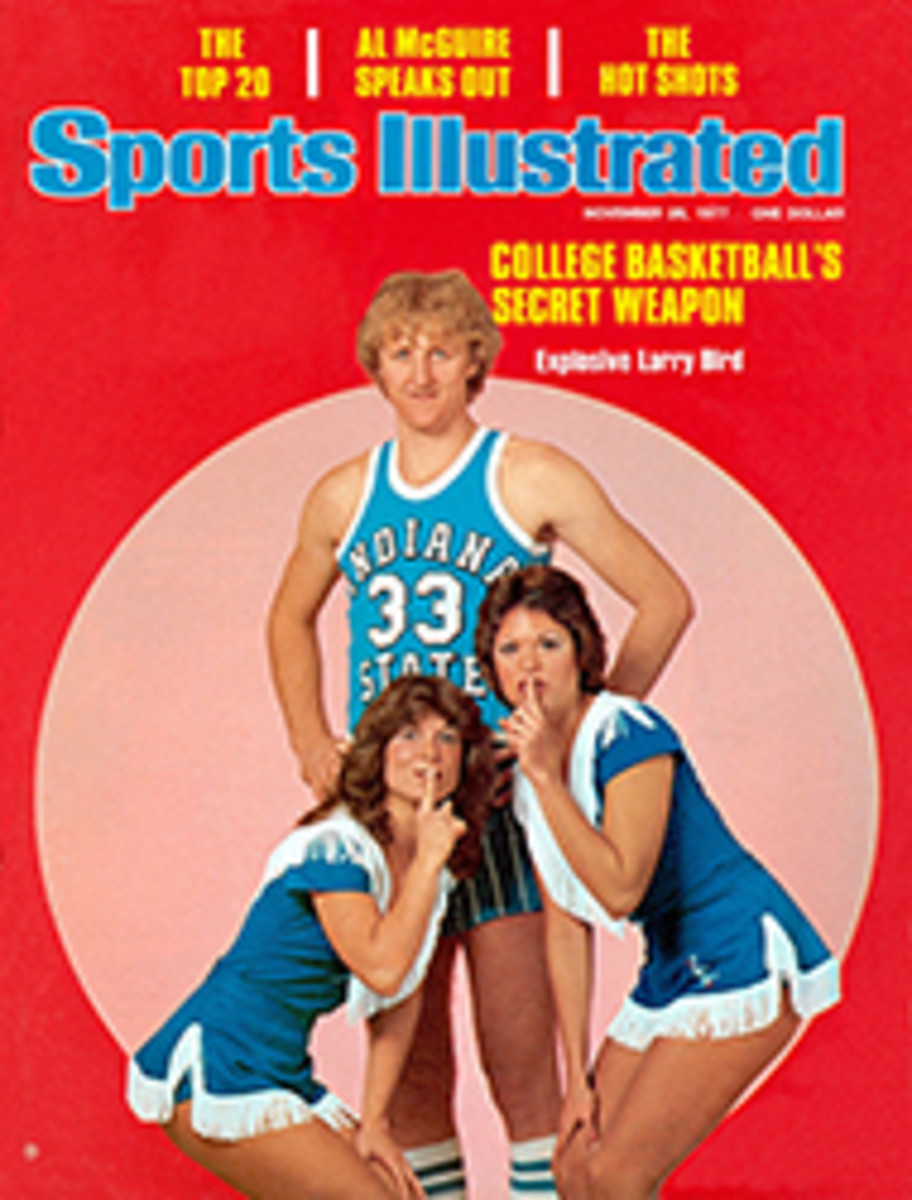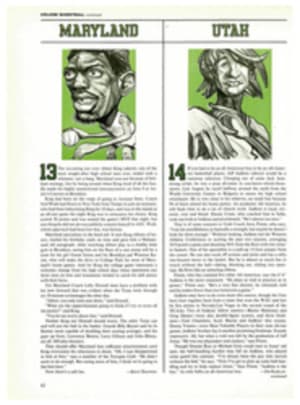
THE WOMEN CASH IN
They will play games this season in the Superdome, Madison Square Garden, the Spectrum and the University of Texas' new $29 million Superdrum, and their national championship will be decided at UCLA's Pauley Pavilion. In recent months 50 colleges sought the services of a 5'10" guard, while others offered free cars to selected sharpshooters. A wealthy Nebraska alumnus tried to press spending money on a gunner from Kansas, and Joe Namath wrote letters extolling Alabama to out-of-state high-schoolers. Tall foreigners have been imported from Australia, Germany, Denmark and Holland, and coaches and athletes have switched colleges like squirrels jumping from limb to limb. And, of course, the University of Nevada, Las Vegas has been under investigation for recruiting violations.
Sound familiar? Sure, it does; but what's different is that all of the above is occurring in the women's game, where 1977 heralds the beginning of the age of big bucks and big-time recruiting.
Perhaps money will not buy the 1978 title—a few small colleges are still good enough to make a run at the national championship this season—but certainly large schools with hefty budgets are moving to center court. An early indication of this came last spring when LSU, Tennessee and Baylor finished second, third and fifth, respectively, in the national tournament, which was won by Delta State with Immaculata fourth. In the previous five AIAW championships, only two big schools had been among the top five while Immaculata and Delta State, with a combined enrollment of 3,800, had a stranglehold on the title. Now big has become beautiful. "Large colleges are where it's at," says Forward Cindy Brogdon, who this fall transferred from Mercer (2,000 students) to Tennessee (25,946).
Exhibit A in this trend is North Carolina State. Three years ago State offered a play-for-the-fun-of-it women's program. The year after the men's team won the 1974 NCAA title, the women's squad had a 13-4 record against teams like Catawba, Campbell, Methodist and Meredith and won the state B Division title. It was a start, but at State playing grade-B basketball was embarrassing, especially when up the road small (2,200 students) Elon College won the state Class A championship.
In the spring of 1975 Athletic Director Willis Casey, a strong supporter of women's athletics, decided it was time to upgrade the Wolfpack program. He began by hiring Elon's coach, Kay Yow. "Obviously, she knew what she was doing," he says. "She talked like a coach, demanded a quality program and wanted to win."
Win she did, in her first year leading the Wolfpack to a 19-7 mark and the state title. "That season we really had just one play," says a State fan. "Get the ball to Susan Yow [the coach's All-America sister] and hope she shoots."
That strategy was good for only one year, because Susan, a transfer from Elon, graduated in '76. Last season Yow had to rebuild. Cristy Earnhardt (at left in drawing), the team's second-leading scorer (17.5 points per game) and rebounder (8.3), was back, but at 5'9" she was woefully short to play center. To strengthen the inside game, Yow recruited 6'2" Genia Beasley (at right in drawing), a three-time all-stater in North Carolina, and 6'5" June Doby, who had led Union Pines (N.C.) High School to the state championship. For experience, Yow turned to her cross-town farm club, Peace (Junior) College, and landed 5'11" identical twins Kaye and Faye Young, double trouble on offense (52% from the field) and terrors on defense. The young, aggressive team had a 21-3 record and was ranked 10th in the nation.
That the Wolfpack had become a national power was evident in a game against three-time champion Immaculata last January. Down by 19 points at the half, State came back to tie the Mighty Macs at the buzzer, only to lose 95-90 in overtime. Yow was ecstatic, saying, "We proved we could play with the best." The team also proved it could attract a crowd, 4,000 fans braving a rare North Carolina snowstorm to cheer on the Wolfpack. "If it hadn't snowed we would have had maybe 10,000," says Casey. "Within five years I believe the women here will be averaging 8,000 spectators, more than the national men's average, and we'll be making money."
Casey has kept State sports in the black, but not at the expense of the women's program. In four years its budget has risen from $20,000 to $300,000 and its scholarships from none to 46 (12 for basketball, the AIAW limit). Yow recently moved into a spacious four-room office complex at Reynolds Coliseum that will accommodate a staff including a full-time assistant coach, three graduate assistants, two managers, a full-time trainer and a secretary. Yow's new assistant, Nora Lynn Finch, the former head coach at Peace, says, "No college gives its women's team the kind of administrative backing that Casey has given ours. He is not just tolerating us because it is fashionable; he really believes in us."
So, apparently, do a lot of other folks. Forty-five students have signed up to play in the pep band at women's games, Yow was named Tar Heel of the Week (an honor usually bestowed on one of North Carolina's businessmen, doctors or lawyers), a special women's sports brochure has gone to press, and the homecoming issue of Wolfpack News published a feature entitled, WOMEN CAGERS HEADED TO TOP.
The enthusiasm is justified. "State has so much talent this year I don't know how anyone can stop them," says Tennessee Coach Pat Head. To make sure no one does, Yow and Finch have been working on new tactics that include John Wooden's fast-breaking UCLA offense and Bob Cousy's man-to-man Boston College defense. Three weeks ago Yow called Portland Coach Jack Ramsay to discuss the Trail Blazer offense. "I think we can run some plays off it," says the prematurely gray 35-year-old coach, who like Ramsay stresses team play.
And she now has enough talent to use a balanced attack. Leading the holdovers is Beasley, who averaged 17.5 points and 11.3 rebounds last season. After seeing her play, former Marquette Coach Al McGuire said, no doubt with a touch of his customary hyperbole, "She's the best shooter, man or woman, I've ever seen." The center's weakness was defense, but after playing on the U.S. Junior Pan-Am team last summer, she can match elbows with anyone.
Earnhardt, once again the second leading scorer (15.9) and rebounder (7.3), will be popping her 10-foot jumper, and Yow has eight other letterwomen, including the Young twins and Doby, who blocked 33 shots last year. State's starting guards graduated, but have been replaced by the two best high school players in Virginia, if not the country: Ginger Rouse and Trudi Lacey. Both are 5'10", can dribble behind their backs without breaking stride and have exceptional body control.
State used to set up on offense 95% of the time. Now, with the two-speedy young Virginians and with Beasley 12 pounds lighter, it will be zip, zip, swish.
Despite all this talent the Wolfpack will not have an easy road to the national title because the Southeast region is the toughest in the country. There are other powerhouses at Tennessee, Old Dominion, Tennessee Tech, Memphis State and Kentucky. At Tennessee, All-America Trish Roberts is gone, but Coach Head went through Georgia like Sherman. She snatched Cindy Brogdon and Jan Seay from Mercer and recruited two Georgia all-staters, Cindy Ely and Debbie Groover, to go with fleet holdover Guard Holly Warlick.
In practice the Vols wear bright orange T shirts emblazoned With OFFENSE SELLS TICKETS BUT DEFENSE WINS THE GAME. It is going to have to, because Tennessee lacks a strong inside game to match North Carolina State's or Old Dominion's. ODU has 6'5" Danish wonderwoman Inge Nissen and 5'10" Olympian Nancy Lieberman back. New Coach Marianne Stanley, a former Immaculata star, arrived in Norfolk with two ex-Mighty Mac forwards, Dolly Van Buskirk and Linda Jerome, who should lead the Monarchs into the Top Ten. Tennessee Tech lost four starters, but leading scorer Gayle Burgess (15.7 points), 6'5" Center Trish Bell and speedy Forward Pam Chambers are still around. They might be enough to take the Golden Eaglettes to the nationals for the seventh straight time. Memphis State and Kentucky are building rapidly and could surprise.
In the East, Immaculata has lost Coach Cathy Rush and her 149-15 record to retirement, All-America Mary Scharff to graduation and Assistant Coach Stanley and two players to Old Dominion. It could be a long season for the once mighty Macs, with Montclair State, led by the nation's leading scorer, Carol (Blaze) Blazejowski (34-point average), St. Joseph's, Rutgers and Maryland on the schedule.
The AIAW's other traditional power, Delta State (109-6 the last four years), will have to play without all-everything Center Lucy Harris and team leader Wanda Hairston, but seniors Debbie Brock, Cornelia Ward and Ramona Von Boeckman are on hand. They give the Lady Statesmen a chance of winning a record fourth straight national title. LSU, which still has its 6'2" Aussies, Maree Bennie and Julie Gross, and Wayland Baptist are among the few teams in the country not hard hit by graduation. Wayland Coach Dean Weese has the starting lineup that averaged 86.9 points a game last year. The Flying Queens, with tall Jill Rankin and strong Marie Kocurek inside, should be among the final four in March. However, Texas is women's basketball country, and Stephen F. Austin, Baylor or Texas could clip the Queens' wings.
In the Midwest, Kansas State is the favorite, while on the West Coast, UCLA, under hew Coach Billie Moore, will field its strongest team ever. Three-time All-America Ann Meyers (18.3 scoring average) is back, along with the team's two other top scorers, Anita Ortega (14.8) and Dianne Frierson (12.2): In the AIAW's new championship format, which will copy the NCAA by bringing only four teams, rather than 16, to the finals at Pauley Pavilion, UCLA will have the easiest region to win. If the Bruins make it to the finals, beware. They have not lost at home since Feb. 5, 1975.
[originallink:10594721:43554]
ILLUSTRATION

